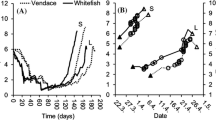Abstract.
Body size is often positively associated with mating success in fish. However, mating success may not accurately represent reproductive success (number of progeny produced). We tested the null hypothesis that reproductive success in male Atlantic cod, Gadus morhua, is not directly proportional to body size. Two allozyme loci and one minisatellite locus were used to estimate the proportion of larvae sired by pairs of males differing in body size and spawning with one female in each of eight tanks during an entire spawning season. Genotypes of progeny from 51 spawning events (egg batches) showed that both males fertilised eggs in each tank. Multiple paternity of larvae occurred in 35 batches. The estimated proportion of larvae sired by each male varied randomly among egg batches within tanks. Male size, condition factor, and total or relative body-weight loss over the season were not correlated with the estimated proportion of larvae sired by each male during the spawning season. Relative activity of males wasmarginally associated with male reproductive success, with more active males siring a larger proportion of larvae. Male reproductive success was affected by female size, with males much larger (>25% total length) than females siring a smaller proportion of larvae.
Similar content being viewed by others
Author information
Authors and Affiliations
Additional information
Electronic Publication
Rights and permissions
About this article
Cite this article
, ., , . & , . Male reproductive success and body size in Atlantic cod Gadus morhua L.. Marine Biology 138, 1077–1085 (2001). https://doi.org/10.1007/s002270100551
Received:
Accepted:
Issue Date:
DOI: https://doi.org/10.1007/s002270100551




